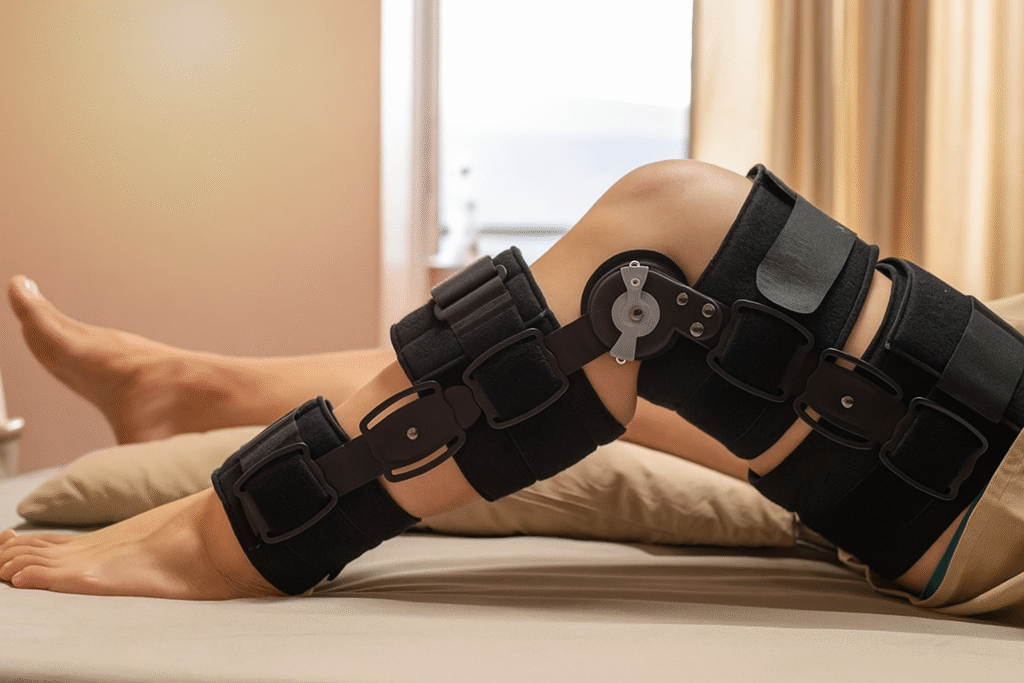
🧬 Introduction: Rethinking ACL Treatment
For decades, a torn anterior cruciate ligament (ACL) was practically a one-way ticket to surgery. Parents of active teens and adults between 40 and 60 years old have often felt the pressure to “fix it now” with a procedure. But what if surgery isn’t always necessary?
A groundbreaking randomized controlled trial published in the New England Journal of Medicine—known as the KANON Trial—challenged this long-standing assumption by directly comparing two treatment strategies:
- Early ACL Reconstruction + Rehab
- Rehabilitation First, with Optional Surgery if Needed Later
The results? Not what most would expect.
🛑 Disclaimer: While this is based on clinical research it is education only and should not be viewed as medical advice.
📊 What Did the Study Find?
The KANON trial followed 121 active young adults (average age: 26) with acute ACL injuries and compared how well they recovered over two years using different treatment paths.
🚨 Key Result:
👉 Structured rehabilitation alone produced equivalent outcomes in pain, knee function, and quality of life compared to early ACL surgery.
| Metric | Early Surgery Group | Rehab-First Group |
|---|---|---|
| KOOS4 (pain, symptoms, function in sports, quality of life) | +39.2 points | +39.4 points |
| Return to pre-injury activity | 44% | 36% |
| Knee-related adverse events | Similar rates in both groups |
Even more surprising: 61% of those who started with rehab never needed surgery at all!
🧒👨👩👧👦 Why This Matters for Teens and Parents (Ages 10–20)
Parents often face difficult decisions when a teenager tears their ACL—especially athletes in sports like soccer, football, cheerleading, or gymnastics.
✅ This study suggests that it’s safe to start with rehab, monitor recovery, and potentially only proceed with surgery if the knee remains unstable.
This means:
- Less disruption to school and sport schedules
- Avoiding unnecessary risks of surgery
- Time to assess emotional readiness and growth maturity
🎯 Pro Tip for Parents: Ask your PT or ortho team about criteria for “copers”—people who do well without surgery—and whether your teen meets those standards.
👨🦳👩🦰 What Adults Aged 40–60 Should Know
If you’re a middle-aged weekend warrior or just tore your ACL doing something unexpected (yes, it happens during ski trips or a game of pickup basketball!), this research offers an important perspective.
💡 Surgery isn’t your only path—especially if:
- Your activity level is moderate (e.g., walking, hiking, gym workouts)
- You don’t experience repeated knee instability
- You’re able to commit to a structured rehab program
🧠 This approach minimizes downtime and reduces surgical risks (like infection, stiffness, or graft complications), which increase slightly with age.
🧠 Why Rehab Alone Can Be So Effective
The KANON study used a well-structured rehab protocol guided by physical therapists. The rehab focused on:
- Restoring full knee motion
- Building muscle strength and neuromuscular control
- Gradual return to function through criteria-based progression
The outcome? Many participants regained high function—even in competitive sports—without surgery.
“It’s not just about healing the ligament—it’s about training the knee and body to function at a high level again,” says Dr. Richard Frobell, the lead author of the study.
🤔 But What About Knee Stability?
Great question. The surgical group did show slightly better mechanical stability (less laxity on knee tests), but this did not translate into better function, pain scores, or return to activity. In other words, you could have a knee that tests “looser” but still works just fine.
🔁 When to Reconsider Surgery
According to the KANON protocol, delayed ACL surgery after trying rehabilitation/physical therapy first was only considered if:
- The patient had persistent episodes of knee buckling or instability
- Rehab progress stalled due to functional limitations
- The patient wanted to return to high-risk pivoting sports and failed non-surgical care
In the trial, 23 of 59 people (39%) eventually had surgery, while the rest improved without it.
💸 The Cost Factor
ACL reconstruction isn’t just physically taxing—it’s financially significant. In the U.S., the average cost of ACL surgery can exceed $20,000 when you factor in the procedure, anesthesia, and rehab. Starting with rehab alone could help avoid unnecessary surgeries and cut healthcare costs—without compromising results.
🧭 Final Thoughts: Choosing the Right Path
Whether you’re a parent managing your teen’s sports injury or an adult trying to stay active later in life, this research offers a roadmap:
- ✅ Start with structured, expert-led rehab
- 🧪 Monitor function and instability symptoms
- 🥾 Consider the Cross Bracing Protocol as an alternative to surgery post ACL injury
- 🔄 Reserve surgery for cases where it’s truly necessary
🏥 How Pain & Performance Coach Can Help
At Pain & Performance Coach LLC, we specialize in:
- Return-to-sport testing with force plates and dynamometers
- Individualized ACL rehab programs based on the latest evidence
- Transparent communication with families and athletes about all treatment options
Whether you’re exploring non-surgical recovery or preparing for ACL reconstruction, we’re here to help you make the best, evidence-based decision.
📍 Serving Hillsboro, Beaverton, Forest Grove, Cornelius, Bethany, and surrounding Oregon areas.
